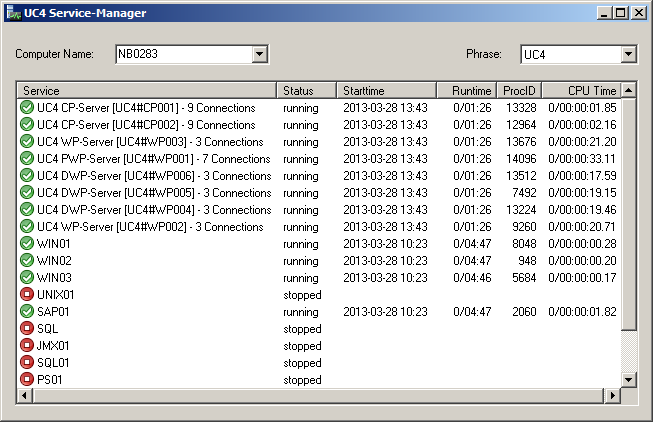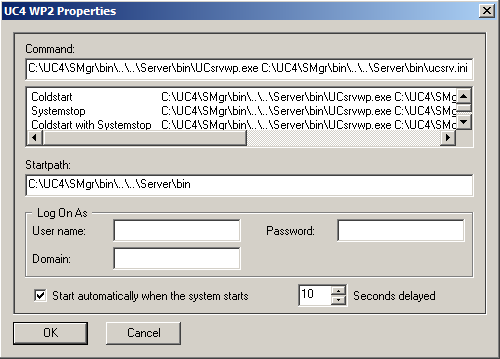The ServiceManager's dialog program is a graphical user interface that you can use to start and stop components. You can monitor your Automation Engine system from a central point with it.
You can handle these components manually, but also via the command line.
The dialog program shows the states of all a ServiceManager environment's components. The ServiceManager environment is also referred to as a Phrase. The dialog program also provides access to ServiceManagers that run on other computers within the network. Therefore, you can access Windows- and UNIX-based Automation Engine programs throughout the system. Access to remote computers requires access rights which are also checked.
Dialog-program contents are periodically refreshed. All fields (except for Computer Name) are empty if a ServiceManager is not active on a selected computer. An error message displays and the fields also remain empty if the access rights for the selected computer are missing.
ServiceManager Window

|
Field/Column |
Description |
|---|---|
|
Computer Name |
Input field for the name of the computer on which the ServiceManager is installed. You can also select from existing entries. Optionally, you can specify the ServiceManager's port number (for example, PC01:8871). Fully qualified domain names are not supported. |
|
Phrase |
Entry field for the ServiceManager environment. This is the environment used in the definitions file and when executing a command. When the computer name has been selected, a familiar ServiceManager environment displays. Users can switch between ServiceManager environments (use dropdown list) if several of them are available. |
|
Service |
Name of the service. You can select any name of your choice and change it at any time. Important! The service name of all Server Processes changes upon starting the service. The name displayed has the format UC4 <server process type>-Server [AUTOMIC#<server process type and connection order>], followed by the number of connections to other processes. The service name you assigned them is displayed again upon stopping the service. Example UC4 WP-Server [AUTOMIC#WP003] - 2 Connections This is the work process that started third and has two connections to other processes. |
|
Status |
The current status of the service. "running" = Program has been started and is running. |
|
Start Time |
Start time of the service. During the start-up phase, the remaining waiting time is displayed in seconds. |
|
Runtime |
The current runtime of the active service. |
|
ProcID |
The process number of the active service. |
|
CPU Time |
The currently used CPU time of the active service. |
Adding Components
First select a computer, then the phrase. The table displays the components you selected. You must add components to this table to have them displayed by the dialog program. By default, the table already includes some entries such as WPs and CPs.
Right-click on an existing table entry and select Duplicate. A new line is immediately created. Assign a suitable name so that you can easily find this component in the list. Then reopen the context menu and select Properties. Enter the start path and other parameters in the dialog that opens:

|
Field/Column |
Description |
|---|---|
|
Command |
File name of the program including the complete path specifications.
You can also specify the name and path of a different INI file if if the default INI file should not be used for the start. Separate this definition from the path and file name using a blank.
Note that Java agents require the parameter -I in front of the INI-file path. There is an additional display option for server processes. Enter the parameter -svc%port% and the server process name plus the number of connections displays in addition to the service name. Java agents (SAP, JMX, Databases and Rapid Automation) must be started via the JAR file. Peculiarities and notes are described below in "Adding Java agents." |
|
Text field below Command |
This area can be used to define several start methods for server processes. Select them by right-clicking the server process. The following parameters can be used to define a start method that executes a cold start; the INI file remains unchanged. Highlight the top line of the text field and right-click it. Use the Insert command to insert lines. Assign a name for the start method. The name you selected here is then displayed in the context menu. The Command field content corresponds to the Command field that is described above. You can also enter the file name, the path to the INI file if needed, and the start parameter -svc%port%. The following parameters are also available: Syntax: -parm"StartMode=value;SystemStop=Value" Allowed values for StartMode=: "NORMAL" (regular start) and "COLD" (cold start) Allowed values for SystemStop=: "NORMAL" (client status remains unchanged) and "YES" (all clients are stopped) The default value for both arguments is "NORMAL". Both arguments are also available in the INI file. The values that are specified in the ServiceManager dialog are given priority. You can specify one or both arguments. |
|
Start Path |
Program's working directory. |
|
Log On As |
User ID under which the program should be processed. UNIX ignores this setting and the program always starts using the ServiceManager's user ID. |
|
User name |
User under whose name the program should run. |
|
Password |
Password for this user. The entry is not shown and the password is saved in encrypted form. |
|
Domain |
Domain to which the user belongs. Required if the user is not a local user. |
|
Start automatically ... |
Check box for the automatic start of the service along with the system. If this check box is selected, the service automatically starts when the system launches. If the service is only needed temporarily (such as for tests), the program can be started and stopped via the context menu. |
|
Seconds delayed |
Waiting time in seconds during which start-up is delayed. If the service appears in the first line of the dialog program, the indicated value is the waiting time for the start of the first service after the ServiceManager has been activated. In other cases, it represents the time lag until the service that is listed in the line above it has started. Automic recommends inserting pauses between process starts to give time for the system to execute these starts. |
The command file Phrase.SMC is automatically created as soon as properties are changed for the first time. The file name complies with the ServiceManager environment. Do not change this file manually..
See also:
ServiceManager - Service
ServiceManager - Command Line Program
Starting and Ending Server Processes